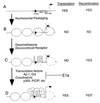Chromatin remodeling directly activates V(D)J recombination
- PMID: 10485904
- PMCID: PMC17961
- DOI: 10.1073/pnas.96.19.10788
Chromatin remodeling directly activates V(D)J recombination
Abstract
V(D)J recombination substrate choice is regulated to ensure that the appropriate gene segments are rearranged during lymphocyte development. It has been proposed that regulation of substrate usage is determined by changes in accessibility of the DNA targets. We show that Rag-mediated recombination of an episomal substrate in cells is affected by its packaging into chromatin. Chromatinized substrates were inefficiently rearranged, and methylation further reduced recombination. Disruption of nucleosomes by using butyrate on methylated substrates was sufficient to activate recombination, and dexamethasone could activate recombination in the absence of detectable transcription. Therefore, chromatin structure, and its manipulation by altering nucleosome positioning, can directly affect recombination efficiencies.
Figures





Similar articles
-
RAG-1 and RAG-2, adjacent genes that synergistically activate V(D)J recombination.Science. 1990 Jun 22;248(4962):1517-23. doi: 10.1126/science.2360047. Science. 1990. PMID: 2360047
-
Unequal access: regulating V(D)J recombination through chromatin remodeling.Cell. 2000 Nov 22;103(5):699-702. doi: 10.1016/s0092-8674(00)00173-2. Cell. 2000. PMID: 11114326 Review. No abstract available.
-
Epigenetic regulation of antigen receptor rearrangement.Clin Immunol. 2003 Oct;109(1):29-36. doi: 10.1016/s1521-6616(03)00199-2. Clin Immunol. 2003. PMID: 14585273 Review.
-
A V(D)J recombinase-inducible B-cell line: role of transcriptional enhancer elements in directing V(D)J recombination.Mol Cell Biol. 1993 Oct;13(10):6223-30. doi: 10.1128/mcb.13.10.6223-6230.1993. Mol Cell Biol. 1993. PMID: 8413222 Free PMC article.
-
Germline transcription: a key regulator of accessibility and recombination.Adv Exp Med Biol. 2009;650:93-102. doi: 10.1007/978-1-4419-0296-2_8. Adv Exp Med Biol. 2009. PMID: 19731804 Review.
Cited by
-
Regulation of V(D)J recombination: a dominant role for promoter positioning in gene segment accessibility.Proc Natl Acad Sci U S A. 2002 Sep 17;99(19):12309-14. doi: 10.1073/pnas.182166699. Epub 2002 Aug 26. Proc Natl Acad Sci U S A. 2002. PMID: 12196630 Free PMC article.
-
Pax5 is required for recombination of transcribed, acetylated, 5' IgH V gene segments.Genes Dev. 2003 Jan 1;17(1):37-42. doi: 10.1101/gad.1031403. Genes Dev. 2003. PMID: 12514097 Free PMC article.
-
An activation-induced cytidine deaminase-independent mechanism of secondary VH gene rearrangement in preimmune human B cells.J Immunol. 2008 Dec 1;181(11):7825-34. doi: 10.4049/jimmunol.181.11.7825. J Immunol. 2008. PMID: 19017972 Free PMC article.
-
Control of V(D)J Recombination through Transcriptional Elongation and Changes in Locus Chromatin Structure and Nuclear Organization.Genet Res Int. 2011;2011:970968. doi: 10.4061/2011/970968. Epub 2011 Sep 29. Genet Res Int. 2011. PMID: 22567371 Free PMC article.
-
Recombinase-activating gene (RAG) 2-mediated V(D)J recombination is not essential for tumorigenesis in Atm-deficient mice.Proc Natl Acad Sci U S A. 2000 Jun 6;97(12):6664-9. doi: 10.1073/pnas.97.12.6664. Proc Natl Acad Sci U S A. 2000. PMID: 10841564 Free PMC article.
References
Publication types
MeSH terms
Substances
LinkOut - more resources
Full Text Sources

